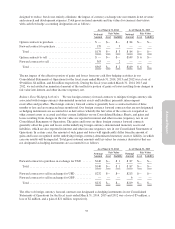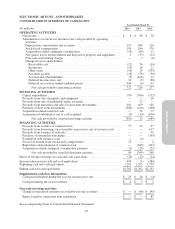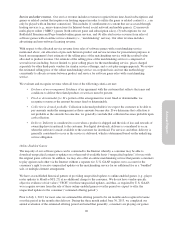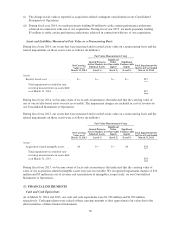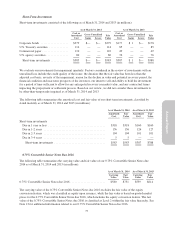Electronic Arts 2014 Annual Report Download - page 137
Download and view the complete annual report
Please find page 137 of the 2014 Electronic Arts annual report below. You can navigate through the pages in the report by either clicking on the pages listed below, or by using the keyword search tool below to find specific information within the annual report.
Annual Report
Short-term investments consist of securities with original or remaining maturities of greater than three months at
the time of purchase, are accounted for as available-for-sale securities and are recorded at fair value. Short-term
investments are available for use in current operations or other activities such as capital expenditures and
business combinations.
Unrealized gains and losses on our short-term investments are recorded as a component of accumulated other
comprehensive income in stockholders’ equity, net of tax, until either (1) the security is sold, (2) the security has
matured, or (3) we determine that the fair value of the security has declined below its adjusted cost basis and the
decline is other-than-temporary. Realized gains and losses on our short-term investments are calculated based on
the specific identification method and are reclassified from accumulated other comprehensive income to interest
and other income (expense), net, and gains on strategic investments, net, respectively. Determining whether the
decline in fair value is other-than-temporary requires management judgment based on the specific facts and
circumstances of each security. The ultimate value realized on these securities is subject to market price volatility
until they are sold.
Our short-term investments are evaluated for impairment quarterly. We consider various factors in determining
whether we should recognize an impairment charge, including the credit quality of the issuer, the duration that
the fair value has been less than the adjusted cost basis, severity of the impairment, reason for the decline in
value and potential recovery period, the financial condition and near-term prospects of the investees, our intent to
sell and ability to hold the investment for a period of time sufficient to allow for any anticipated recovery in
market value, and any contractual terms impacting the prepayment or settlement process. If we conclude that an
investment is other-than-temporarily impaired, we recognize an impairment charge at that time in our
Consolidated Statements of Operations.
Inventories
Inventories consist of materials (including manufacturing royalties paid to console manufacturers), labor and
freight-in and are stated at the lower of cost (using the weighted average costing method) or market value. We
regularly review inventory quantities on-hand. We write down inventory based on excess or obsolete inventories
determined primarily by future anticipated demand for our products. Inventory write-downs are measured as the
difference between the cost of the inventory and market value, based upon assumptions about future demand that
are inherently difficult to assess. At the point of a loss recognition, a new, lower cost basis for that inventory is
established, and subsequent changes in facts and circumstances do not result in the restoration or increase in that
newly established basis.
Property and Equipment, Net
Property and equipment, net, are stated at cost. Depreciation is calculated using the straight-line method over the
following useful lives:
Buildings ..................................... 20to25years
Computer equipment and software ................. 3to6years
Office equipment, furniture and fixtures ............. 3to5years
Warehouse equipment and other ................... 5years
Leasehold improvements ......................... Lesser of the lease term or the estimated useful lives
of the improvements, generally 1 to 10 years
We capitalize costs associated with internal-use software that have reached the application development stage and
meet recoverability tests. Such capitalized costs include external direct costs utilized in developing or obtaining the
software, and payroll and payroll-related expenses for employees who are directly associated with the development
of the software. Capitalization of such costs begins when the preliminary project stage is complete and ceases at the
point in which the project is substantially complete and is ready for its intended purpose. The net book value of
capitalized costs associated with internal-use software was $74 million and $81 million as of March 31, 2014 and
2013, respectively. Once the internal-use software is ready for its intended use, the assets are depreciated on a
straight-line basis over each asset’s estimated useful life, which is generally three years.
67


